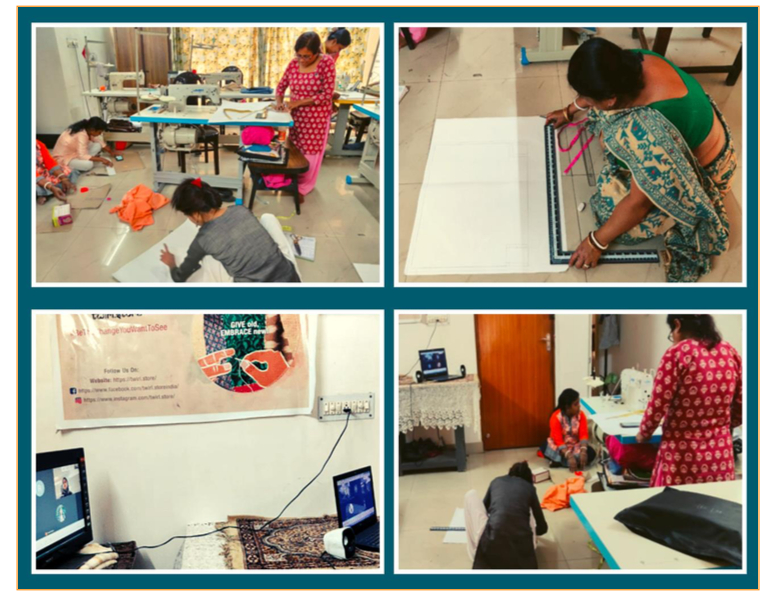Designing for Inclusion within Circularity- A Prototype On-ground

Mumbai, 8 September – Circular Apparel Innovation Factory’s Project Circular+ gave them an unique opportunity of innovative prototyping. From discovery of ideas to solution building through a working group led engagement; and finally testing on ground in the form of a pilot. The journey itself was a learning curve. It serves as a case study of collaboration and co-creation. CAIF’s efforts, along with their partners resulted in completing 120+ hours of virtual training that covered 19 structured modules on diverse facets of production and witnessed a remarkable change.
CAIF not only found increased skill levels among the women workers, but more importantly, their enhanced confidence, motivation and income potential was the highlight of the project.
Nancy Charaya from CAIF, Intellecap shares more in her blog on the CAIF Circular+ Case Study.
As we envision the fashion (incl. textiles and apparel) industry’s transition towards the circular economy, the adoption of circular business models that are both planet and people positive is crucial.
Project Circular+ (conceptualized, designed and implemented with support from Laudes Foundation), launched by Circular Apparel Innovation Factory (CAIF) in May 2020, was born from that vision. Circular+ aimed to create a model for collaborative and innovative prototyping for inclusive circular business models in India.
This case study captures several stages of the process beginning with the journey from arriving at the collaborative prototype (through an industry working group), from outlining the objectives of the prototype that informed the pilot design, to executing the pilot and learnings from it and finally articulating a few priority lenses that we believe can significantly inform the design of future interventions to scale planet and people positive impact through circular business models – both in India and beyond.
In short, the case study is structured in four (4) parts:
PART I – Getting to the collaborative prototype & defining prototype objectives
An innovation challenge was launched to surface existing circular business models, and 4 enterprises were shortlisted to become a part of the working group from an initial list of 20 enterprises we engaged with.
We curated a diverse set of industry stakeholders who represented points of view from brands, manufacturers, ecosystem enablers, venture capital, policy research and think tanks, accelerators, and technology enterprises who were directly or indirectly part of the fashion value chain. These 4 innovators formed 4 ideas labs within the working group, and each of them developed collaborative prototypes that were tested on the ground.
The jury selected one enterprise (Twirl.store) based on the scalability potential of the inclusive circular business model for piloting.
About Twirl – Twirl operates on an upcycling model geared to minimize post-consumer waste by providing a new life to unused clothes and diverting textiles/apparel waste away from landfills. It provides a solution for collecting and upcycling unused clothes lying in consumer wardrobes into aspirational handcrafted products while strengthening livelihood for women artisans.
PART II – Design and delivery of the prototype & its activities
To provide early evidence of success, the prototype had to meet two objectives:
- Skill building and capacity building amongst Twirl’s women artisans to improve their income potential.
The curriculum was designed in consultation with the Twirls team and a 3- month training program was delivered virtually via training partner i.e. Master G. Multiple other workshops were also conducted such as photography, gender training to build additional competencies and generate awareness.
- Identifying and establishing market linkages that would generate demand for upcycled products made from post-consumer waste.
Existing marketplaces with sustainability focus were identified as great potential partners for Twirl to unlock alternate sales potential. Some B2B partnerships were explored that helped create a stronger pipeline for regular orders.
PART III – Outcomes achieved, and the potential to scale
The women artisans at Twirl underwent 120+ hours of training through 19 structured modules to augment their skill sets and capacities related to different production aspects. Such extensive training (and handholding) has helped these women gain expertise in improving the quality of products aligned to market requirements and also to enhance their self-development.

The team was successful in helping Twirl launch its products on two online retail Marketplaces – Kakul and LBB and is in the process of delivering products to a third platform called Kiabza. On the B2B partnership front, the team supported Twirl to enter into a B2B partnership with Sirohi.
PART IV – Learnings from the prototype
Download the Case Study and read more here– Case Study Circular +
Read the CAIF Blog – Here




